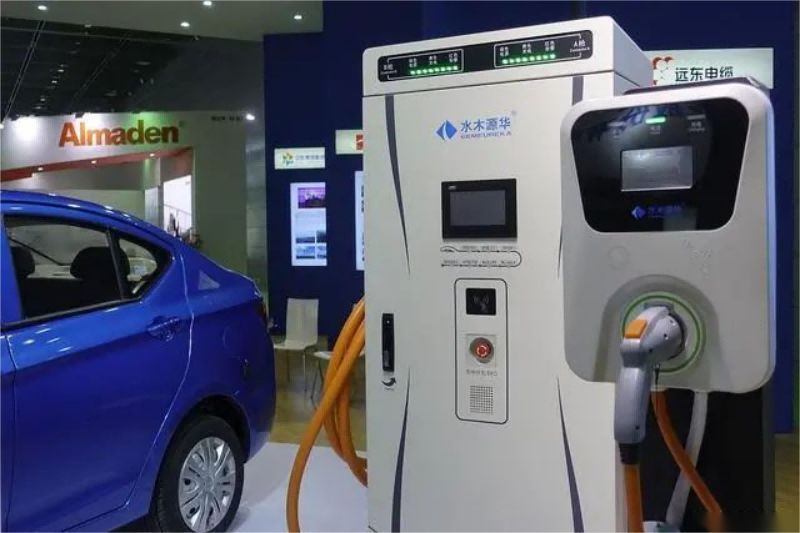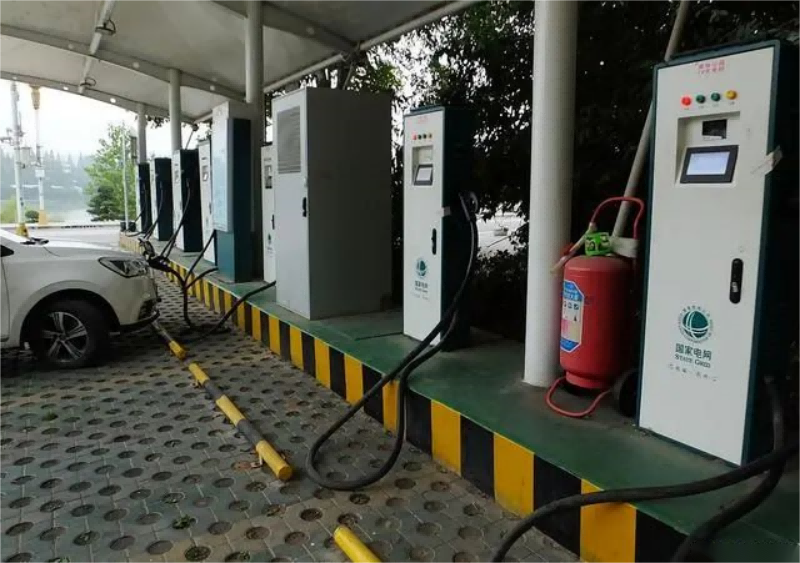Author:MarwenDate:2023-12-13

The first "China Automobile Charging and Swapping Ecological Conference" will be held in Fuyang, Hangzhou from December 19th to 21st. The conference will conduct in-depth exchanges and discussions on topics such as "charging and swapping infrastructure construction", "charging piles in rural areas", "high-quality charging services", "power swapping models", "overseas exports" and "vehicle network interaction".
The development of the new energy vehicle industry has always been constrained by range anxiety. As the penetration rate of the industry increases, the market scale of new charging piles and charging stations will also further expand. According to the forecast of Yiou Think Tank, the market size will gradually grow from 33.7 billion yuan in 2023 to 106.1 billion yuan in 2030.

Charging pile industry chain review
The upstream of the charging pile industry chain is mainly composed of component manufacturers, which mainly provide traditional electronic components for the entire pile product; the midstream includes charging pile manufacturers and charging facility operators; the downstream is mainly composed of new energy sources with rigid charging needs. The composition of automobile manufacturers.
The upstream mainly consists of component suppliers of charging pile equipment, such as charging modules, relays, contactors, monitoring and metering equipment, charging guns, charging cables, main controllers, communication modules, etc.
As the core component of DC charging equipment, charging modules are represented by Youyou Green Energy, Tonghe Technology, Xu Ji Electric, etc.
The midstream mainly includes charging pile manufacturing companies and operators. These two parts of the business overlap, and many mainstream charging pile companies adopt a "production + operation" integrated model. Representative companies include Shenghong Co., Ltd., Green Energy Huichong, China Southern Power Grid, etc.
The downstream is mainly dominated by new energy electric vehicle manufacturers and charging service operators, such as Weilai, Tesla, BYD, etc.
The entire manufacturing process mainly involves the assembly of modules, charging guns and other components. Among them, the module is the core component of the charging pile and is responsible for the control and conversion of the circuit to ensure the efficiency and stability of the circuit power supply.

Liquid cooling overcharging: core trend in charging
The current high power leads to a significant increase in thermal effects, so the thermal management method is changing from air cooling to liquid cooling, which is mainly reflected in the liquid-cooled charging module and liquid-cooled charging gun line, and promotes the innovation of design structures such as pile body cooling channels.
Liquid cooling overcharging has multiple advantages. First of all, because the module is isolated from the external environment, it can effectively reduce the damage rate of charging equipment and improve the safety and service life of the equipment. Secondly, the heat dissipation capacity of the liquid-cooled charging pile is increased by 50%, while the number of power devices is reduced, making the entire module comply with the IP97 protection level and improving reliability. In addition, the liquid-cooled charging pile also adopts a discrete heat dissipation solution and a large-blade fan, which greatly reduces the noise output of the system.
Liquid cooling technology ensures a 10-year service life. The maximum power of a fully modular single cabinet is 720kW and has an output capacity of 12 guns. The utility rate of mains power is increased by 30%, and the total cost of ownership (TCO) is reduced by 40%.
At present, the investment amount of liquid-cooled supercharged piles is still higher than that of traditional DC piles, but large-scale cost reduction has yet to be achieved.
In view of the steady growth of China's new energy vehicle market size and product competitiveness, it is expected that 2023 will be the first year for the launch of the supercharged new energy vehicle market. As more supercharged batteries are mass-produced and applied to automobiles, the market is expected to enter an explosive period lasting 5-7 years in 2024.

During the National Day in 2023, Huawei's fully liquid-cooled supercharging station was completed on the Sichuan-Tibet Line, marking the accelerated progress of supercharging technology. The maximum power of this supercharging station is 600kW and the maximum current is 600A, achieving "one kilometer per second" fast charging.
At the Shanghai Auto Show in April 2023, Huawei's fully liquid-cooled supercharger has been unveiled. This technology integrates optical storage technology and realizes the application of liquid cooling, high-voltage protection, power distribution and other technologies, thereby increasing the 10-year internal rate of return (IRR) to 66.7%.
High power also means that the impact on the power grid will increase significantly, so the importance of equipped with energy storage systems has become increasingly prominent. From 450V to 800V overcharging platform, components with increased costs include power battery packs, drive motors, high-voltage wiring harnesses, thermal management systems, and fuses. The increase in the size of the related parts and components market is expected to reach approximately 17.8 billion yuan in 2025, and will further increase to approximately 54.3 billion yuan in 2030.
liquid cooling module
Conventional charging piles mainly use air-cooled heat dissipation, using thermal conductive materials and high-speed fans to dissipate heat from the inside of the charging pile. This method is cheaper, but has obvious limitations in terms of heat dissipation efficiency, noise and service life.
In contrast, liquid-cooled overcharging uses liquid heat dissipation, and its structure is significantly different from traditional air-cooled modules.
The liquid-cooling module includes components such as water-cooled heads, liquid-cooling plates, piping systems, and liquid-cooling pumps. It uses specialized liquid circulation channels and coolant for heat dissipation, thereby achieving higher heat dissipation efficiency and better performance.
At present, the production of charging modules mainly involves suppliers with technical accumulation such as Infineon, Huawei and ZTE.
With the decline in the price of charging modules and the development trend of high power, intelligence and network platform, charging pile manufacturers such as Te Laidian and Shenghong Co., Ltd. have gradually entered the production process of charging modules and achieved self-production and self-research.
Liquid cooled gun line
The liquid-cooled charging gun can achieve more efficient fast charging and can effectively solve the heat dissipation problem during the charging process.
Compared with traditional charging guns, liquid-cooled charging guns have better heat dissipation performance and can therefore handle larger currents without overheating.
This means that the liquid-cooled charging gun can allow higher current input while ensuring safety, thereby increasing charging power, shortening charging time, and improving charging convenience.
Charging pile manufacturing competition landscape and leader sorting out
At present, the number of domestic suppliers of midstream charging piles has exceeded 300. my country's charging pile industry is mainly divided into two major markets: on-network and off-network. The in-network market mainly refers to the centralized bidding of public charging piles led by the State Grid, China Southern Power Grid and local power grids. The off-network market is mainly composed of private charging stations. Private operating companies such as Te Laidian, Xingxing Charging, and Wanma Aichong are the main participants in this market.
From January to June 2023, my country added 351,000 public charging piles, including 147,000 DC public charging piles. There is an obvious trend of concentration at the top of the industry. In the first half of 2023, the top three companies that added public charging piles accounted for 56.4% of the market share, and the top five companies accounted for 71.9% of the market share.
Due to the dual promotion of domestic policies and demand, the charging pile construction industry maintained a high level of prosperity during the year. In the medium to long term, the increase in exports to the European and American markets and the proportion of DC piles will further open up the industry's development space.
Complete companies and module companies with a high proportion of DC charging piles include Green Energy Huichong, Jinguan Co., Ltd., Tonghe Technology, Shenghong Co., Ltd., Daotong Technology, Jinguan Electric, Lihexing, Taiyong Changzheng, Teruide, Xiangshan Co., Ltd. , Continental, Inkerui, Wall Nuclear Materials, Yonggui Electrical Appliances and Juhua Technology, etc.
There are many manufacturers related to the upstream and downstream layout of charging piles. Representative manufacturers include CATL, Hanchuan Intelligent, Shandong Weida, GCL Nengke, Tonghe Technology, Yonggui Electric, Wemax, Xinhongye, etc.
In addition, car companies are keen on deploying high-power charging technology, and this trend is becoming increasingly significant. DC charging plays a key role in replenishing energy for electric vehicles on highways and in urban and rural public scenes. Currently, China's major automobile companies are accelerating the research and development of high-power charging technologies of 120kW and above, and are actively launching related super-fast charging products, including Xpeng's S4 supercharger (maximum power 480kW), Geely's Vair Supercharger Charging 2.0 (maximum power 600kW), and Aian's A480 super charging pile (maximum power 480kW), etc.
↓Next [ Do you know some knowledge about new energy vehicles? ]









